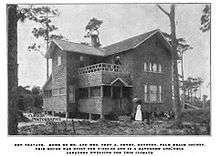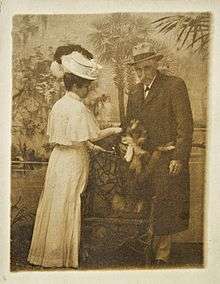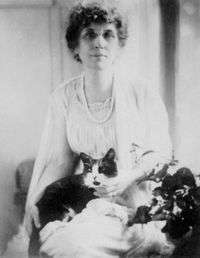Byrd Spilman Dewey
| Byrd Spilman Dewey | |
|---|---|
|
Byrd Spilman Dewey, 1918 | |
| Born |
Julia Bird Spilman February 16, 1856 Covington, Kentucky, U.S. |
| Died |
April 1, 1942 (aged 86) Jacksonville, Florida, U.S. |
| Resting place | Greenlawn Cemetery |
| Pen name | Aunt Judith Sunshine, Judith Sunshine, Aunt Judith, Judith Ray |
| Occupation | Writer |
| Language | English |
| Nationality | American |
| Alma mater | Sayre Institute |
| Period | 1887–1927 |
| Genre | Fiction, animal stories, Florida pioneer |
| Notable works | Bruno, 1899 |
| Spouse | Fred S. Dewey |
Byrd "Birdie" Spilman Dewey (February 16, 1856 – April 1, 1942) was an American author, land investor, and co-founder of the Town of Boynton. She lived in Florida from 1881 until her death in 1942.[1] Her best known work, Bruno, told the Dewey's story of early pioneering days in central Florida. The book remained in print for over twenty years, classified as juvenile literature – today it is classified as young adult literature.
Mrs. Dewey was an important figure in pioneer South Florida history, adding philanthropy, and environmental conservation to her notable endeavors with her work in the Florida Audubon Society. In 2013, she was a finalist for the Florida Women's Hall of Fame.[2]
Early life
Byrd Spilman Dewey was born Julia Bird Spilman in Covington, Kentucky to Jonathan Edwards Spilman and Eliza Sarah Taylor.[3] Her maternal great-grandfather was Colonel Richard Taylor, father of President Zachary Taylor. Mrs. Dewey's father was an attorney, composer and Presbyterian minister. He wrote the 19th-century song "Flow Gently Sweet Afton". Her mother died on August 10, 1866, as the result of a fire aboard the steamboat "Bostona No. 3" in Maysville, Kentucky.[4][5]
She attended school in Kentucky including Maysville College and the Sayre Institute (Sayre School) where she studied literature, music, art, and language skills. In 1877 she moved with her family to Salem, Illinois, to her father's next pastorate. It was there that she met Frederick Sidney Dewey; they were married on September 25, 1877.[6] Fred was a distant cousin of Admiral George Dewey, and also of Melvil Dewey, the inventor of the Dewey Decimal System.[7]
Move to Florida
Because of Fred S. Dewey's respiratory ailments, contracted during his service in the American Civil War, the Deweys moved to Florida in 1881. They arrived in Jacksonville where they looked at properties in the St. Augustine area. They bought 20 acres (81,000 m2) of land in Zellwood intending to grow vegetables and raise an orange grove. By 1883 the land proved unsuitable for vegetables and the orange trees still needed years before reaching maturity. The Deweys sold the land and moved to Eustis where Fred took a bookkeeping position.[8]
Life in Eustis was unsatisfying for the Deweys, so they moved back to Jacksonville, where Fred worked for the T.V. Cashen Lumber Company as a bookkeeper. In 1885 Byrd Spilman Dewey gave birth to Elizabeth Dewey (referred to as "Little Blossom" in Bruno) who died while an infant – the only child the Deweys ever bore.[9]
In 1887 the Deweys heard of a new frontier opening to the south – the Lake Worth Country. The land surrounding Lake Worth, a 22-mile (35 km) long lagoon, was just beginning to open up for settlements. The Deweys filed a homestead claim for 76 acres (310,000 m2) of property one mile west of Lake Worth on Lake Mangonia. They cultivated about 2 acres (8,100 m2) in coconuts, tamarind, pineapple, avocado, sugar apple, and guava. Fred sailed across Lake Worth each day to the tiny settlement of Palm Beach to do bookkeeping or carpentry work.[10]

Writing career
Byrd Spilman Dewey's first known work appeared in the Florida Farmer and Fruit Grower newspaper[11] in 1887. She contributed to the column "Our Home Circle" by Helen Harcourt under the pen name Aunt Judith Sunshine. She provided recipes and household tips on dealing with the harsh South Florida environment. In 1887 she published her first article in a national magazine, the Christian Union entitled "On Toast". She followed that article with others in the Christian Union such as "Our Perfect Home (suggested by What I Covet)" and "The Wall Furniture in Our Perfect Home"; all under the pen name of Judith Sunshine. In the period between 1889 and 1895 she published a series of articles in Good Housekeeping, mostly short stories on a variety of moral and home topics.[10]
In 1891, Mrs. Dewey became the first columnist in Guy Metcalf's newspaper The Tropical Sun. She began publishing her weekly column "The Sitting Room" in April 1891 and wrote the column through September 1891. Her byline for the columns was "Aunt Judith". She also signed several poems, short stories, advice columns, and recipes with the initials J. S. The column featured housekeeping advice, philosophy on family and married life, and recipes suited for the tropical household. In 1896 she published her first work under her own name in the Lake Worth Historian, a publication produced by the pioneer women of Lake Worth as a fundraiser for the Royal Poinciana Chapel.[12]
Little, Brown & Company published her sentinel work, Bruno, in 1899. The book sold well across the country—more than 100,000 copies during its first year of publication—and was received well in national reviews.[13] It was featured as a standard reader in several school catalogs around the United States.[14] The book was autobiographical in nature, with Mrs. Dewey becoming the character of "Judith" and her husband the character of "Julius". That the book served as an autobiography was confirmed in the 2012 biography of the Deweys, Pioneering Palm Beach: The Deweys and the South Florida Frontier, where the authors were able to match land records and events to the book's storyline.[8] The Historical Society of Palm Beach County awarded the book the Fannie James Award for Pioneer Research Achievement.[15]
Her second book, The Blessed Isle and its Happy Families, was published in 1907 by the Press of the Record Company. This book told the stories of the cats and dogs that graced the Dewey home in West Palm Beach, Florida during the 1890s to early 1900s. The book had its genesis from a series of articles Mrs. Dewey published in Vogue magazine. The stories took place at Ben Trovato, the Dewey homestead on Lake Worth where they had moved following the sale of their 76 acres (310,000 m2) of property on Lake Mangonia. Her third book, From Pine Woods to Palm Groves, was published in 1909 in serialized form in The Florida Review, a Florida literary journal. This book is set at the beginning of the Dewey's adventures in the nascent Palm Beach County during the time from 1887 to 1893. Ben Trovato served as a focal point for national dignitaries including Henry Phipps, Richard Watson Gilder, and Mr. and Mrs. Woodrow Wilson.[10]
Several of Mrs. Dewey's recipes were included in the 1913 cookbook Economy Administration sponsored by the White House during the Wilson Administration.[16] She continued to write, typically in short story form which she self-published in small pamphlets. Her last published work during her life was in the Florida Naturalist in 1927; titled "Some Bird Notes".[8] In 2014, all of Mrs. Dewey's known works were compiled into one volume--"The Collected Works of Byrd Spilman Dewey." Her cat and dog stories could be compared to the work of contemporary authors such as Gwen Cooper or John Grogran.
Founding the Town of Boynton
As Mrs. Dewey's authorship earnings increased, she began to invest in land in the exploding South Florida real estate market. In 1892 she purchased a tract of land, 160 acres (650,000 m2) at the south end of Lake Worth,[17] from George H. K. Charters for US$700 (equivalent to $18,467 in 2015).[18] In 1895 William S. Linton, a congressman from Saginaw, Michigan, offered her US$6,000 (equivalent to $170,952 in 2015) for her land. Linton had first toured South Florida that year with fellow Michigander Nathan Boynton. Linton entered into a contract with the Deweys where he would pay them US$1,500 (equivalent to $42,738 in 2015) a year for four years. In 1897 Linton became insolvent. The Deweys filed a foreclosure lawsuit in August 1897 against Linton and Boynton. The case was settled out of court in October and the Deweys regained their land.[19] The story of the Deweys' role in the founding of Boynton was featured in the Florida Legacy Productions documentary, Solving the Mystery of Birdie S. Dewey.[20] The Dewey home in Boynton was also named "Ben Trovato" and stood at the southwest corner of Boynton Beach Boulevard and Federal Highway.

Nathan Boynton was credited as the city's founding father[21] until Ginger L. Pedersen and Janet M. DeVries were researching the history of the Boynton Hotel for their 2012 book, Pioneering Palm Beach: The Deweys and the South Florida Frontier. They unexpectedly discovered that the town was actually founded on September 26, 1898, by the Deweys,[22] who filed the original plat for the Town of Boynton in the Dade County courthouse.[18] The Deweys then issued deeds to people who had bought land parcels from Linton, and the couple built a house in Boynton, using it as a weekend home until moving to the town in 1909.[18] Fred Dewey planted the first orange grove in Boynton along the coastal canal, where today's Sterling Village development stands.[23] They donated lots for a Methodist church, donated the proceeds from lot sales to pave streets, and Mrs. Dewey donated a large portion of her personal library to start the town's first library,[24] with the books held at the local post office.[25] The Deweys lived in Boynton from 1909 to 1911, when health concerns forced them to move to Tennessee where Mr. Dewey entered a Civil War soldier's home in Johnson City.[8]

Work with the Florida Audubon Society
After her husband's death in 1919, Mrs. Dewey began to work with the Florida Audubon Society. In 1920 she was named the field secretary, making speeches and presentations around the state in the name of conservation, animal protection, and the creation of bird sanctuaries.[26] She continued her work until her move to Jacksonville in 1928. She occasionally visited the Palm Beach area, until failing health no longer allowed her to travel.[8]
Death
Byrd Spilman Dewey died in 1942 in Jacksonville, Florida following a long illness. She was buried in the Greenlawn Cemetery in South Jacksonville in an unmarked grave. She died with few assets, but a long legal battle ensued between her nieces and nephews and her caregiver. The case went all the way to the Florida Supreme Court and was settled in 1944; with the two parties splitting her assets.[8] In 2012 authors Ginger Pedersen and Janet DeVries placed a marker on her grave with the inscription "I am HOME" – signifying Mrs. Dewey's conception of Heaven:
We long for a sheltered nook, near the River of Life, where we and Little Blossom can resume the life so happily begun here, going over to the Happy Hunting Grounds to get Bruno, and to the Cat Heaven for Rebecca and Catsie. Then, our family circle complete, we would settle down to an eternity of HOME.Byrd Spilman Dewey[27]
Honors
Byrd Spilman Dewey was a top 10 finalist for the Florida Woman's Hall of Fame in 2012 and is currently nominated for the Florida Artist Hall of Fame.
Works
- Periodical articles
- 1887 "On Toast" - The Christian Union
- 1887 "Our Perfect Home (Suggested by What I Covet)" - The Christian Union
- 1888 "The Wall Furniture in our Perfect Home" - The Christian Union
- 1889 "The Tyranny from the Other Side" - Good Housekeeping
- 1890 "At other people's convenience" - Good Housekeeping
- 1890 "A suitable Christmas Present" - Good Housekeeping
- 1892 "You ought to know" - Good Housekeeping
- 1895 "A village tragedy" - Good Housekeeping
- 1895 "Who Seeks Finds" - St. Nicholas Magazine (under pen name Judith Ray)
- 1904 "The Happy Families" (series of four articles) - Vogue
- 1913 "Recipes of Mrs. Byrd Spilman Dewey" - The Economy Administration Cook Book
- 1927 "Some Bird Notes" - The Florida Naturalist
- Newspaper articles
- 1891 "The Sitting Room" - The Tropical Sun
- 1909 "Back Home" - The Maysville Public Ledger
- 1914 "We are Ready for Vote" = "The Maysville Public Ledger"
- Short stories
- 1896 "A Lake Worth Romance"
- 1907 "Peter the Tramp"
- 1907 "Rebecca: A postscript to Bruno"
- 1911 "Flying Blossom"
- 1913 "Tale of Satan"
- 1914 "O Youth Eternal"
- 1917 "Who Seeks Finds"
- Books
- 1899 Bruno[28]
- 1907 The Blessed Isle and its Happy Families
- 1909 From Pine Woods to Palm Groves
- 2014 The Collected Works of Byrd Spilman Dewey ISBN 978-1494892333
- 2015 "Bruno - A New Edition" ISBN 978-1507563151
References
- ↑ "Death Claims Notable Southside Figure". Florida Times-Union. April 2, 1942. p. 18.
- ↑ "http://www.fcsw.net/HallofFame.htm"
- ↑ Hoover, Earl R. J.E. Spilman. Kentucky Register. 1968. p. 222.
- ↑ Carter, L.D. Burning of Bostona No. 3. Gallipolis Journal. 1866. p. 1.
- ↑ "Burning of the Steamer Bostona No. 3." New York Times. August 12, 1866. p. 10.
- ↑ Fred and Birdie Pioneering Palm Beach.
- ↑ Engoren, Jan (June 12, 2013). Historical society's new president continues work to preserve the past. The Sun Sentinel. Retrieved September 5, 2013.
- 1 2 3 4 5 6 Pedersen, G. & DeVries, J. Pioneering Palm Beach: The Deweys and the South Florida Frontier. The History Press. 2012.
- ↑ Elizabeth "Little Blossom" Dewey (1885 - 1885). Find A Grave Memorial.
- 1 2 3 Pedersen, Ginger L. (April 9, 2013). When Curiosity Changes your Life. palmbeachpast.org. Retrieved September 28, 2013.
- ↑ Florida Farmer & Fruit Grower.
- ↑ "A Lake Worth Romance" Lake Worth Historian. 1896. P. 11.
- ↑ "Local News". Lake Worth News. December 27, 1900. p. 2.
- ↑ "Local Notes". Lake Worth News. November 1, 1900. p. 3.
- ↑ Judge James R. Knott Historical Contribution Award. historicalsocietypbc.org. Retrieved September 28, 2013.
- ↑ Root, S. & Rhodes, G.The Economy Administration Cook Book. 1913. Syndicate Publishing Company. p. 156.
- ↑ Hartz-Seeley, Deborah (October 31, 2012). Boynton Beach: Hidden history of city's founding brought to light. The Coastal Star. Retrieved September 5, 2013.
- 1 2 3 Boynton Beach's Founding. boyntonhistory.org. Retrieved September 4, 2013.
- ↑ Big Land Suit in Dade. Indian River Advocate. 1897. p. 1.
- ↑ Solving the Mystery of Birdie S. Dewey and Florida's Final Frontier on YouTube. Retrieved September 28, 2013.
- ↑ Anthony, Attiyya. (June 21, 2013|). Boynton Ocean Avenue Park now Dewey Park. The Sun Sentinel. Retrieved September 5. 2013.
- ↑ Cloutier, M.M. (December 30, 2012). Birdie's Boynton: Meet a city's unsung pioneer. The Daily News. Retrieved September 5, 2013.
- ↑ Citrus Trees Proposed in Boynton Section. The Florida Agriculturalist. 1909. p. 548.
- ↑ Founding documents. historicpalmbeach.com. Retrieved September 4, 2013.
- ↑ Notes from Boynton. Miami Metropolis, June 10, 1910. p. 4.
- ↑ New Field Secretary. Florida Audubon Bulletin. 1920. p. 3.
- ↑ Byrd Spilman "Birdie" Julia Bird Spilman Dewey (1856 - 1942). Find A Grave Memorial.
- ↑ Bruno by Byrd Spilman Dewey. Free Ebook.
External links
- Works by Byrd Spilman Dewey at Project Gutenberg
- Works by or about Byrd Spilman Dewey at Internet Archive
